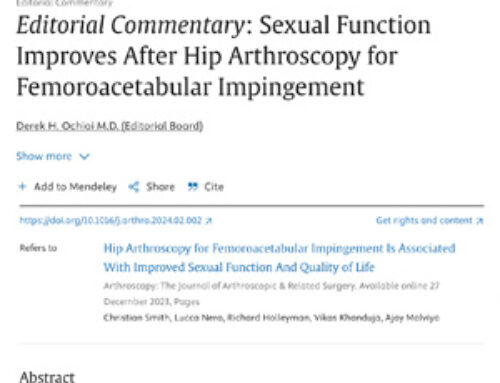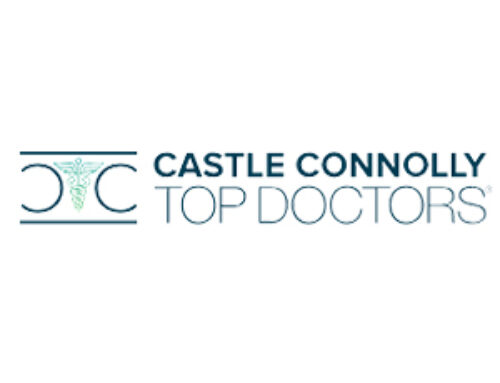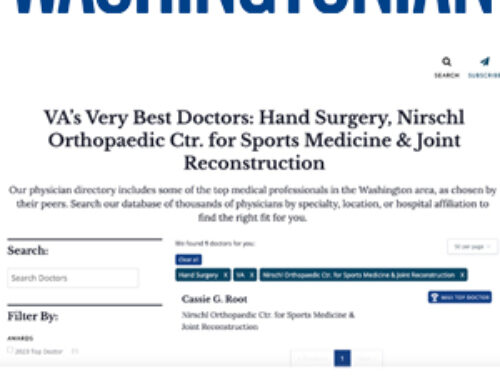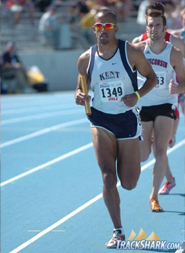 While practically unknown as a cause of hip pain even 20 years ago, it is now recognized that hip labral tears and femoroacetabular impingement (FAI) is a frequent cause of hip pain. Because of the intense training and increased risk of injury while playing their sport, athletes may start having hip pain from FAI and labral tears at an earlier age than non-athletes. I talked about labral tears and FAI in detail in a previous blog https://www.nirschl.com/hip-labral-tears-and-femoroacetabular-impingement-a-frequent-cause-of-non-arthritic-hip-pain-derek-ochiai-md/.
While practically unknown as a cause of hip pain even 20 years ago, it is now recognized that hip labral tears and femoroacetabular impingement (FAI) is a frequent cause of hip pain. Because of the intense training and increased risk of injury while playing their sport, athletes may start having hip pain from FAI and labral tears at an earlier age than non-athletes. I talked about labral tears and FAI in detail in a previous blog https://www.nirschl.com/hip-labral-tears-and-femoroacetabular-impingement-a-frequent-cause-of-non-arthritic-hip-pain-derek-ochiai-md/.
What type of symptoms does an athlete with a labral tear?
Athletes can have very similar pain issues to non-athletes with labral tears. Pain with prolonged sitting, pain with twisting activities, and pain getting in and out of cars is common. However, especially in high level athletes, they sometimes only have pain while either doing their sport or for 1-2 days afterwards. They can also complain of diminished athletic performance. For instance, a tennis player might notice that her serve is less accurate, since they are not rotating their hips in follow-through as much. A baseball pitcher may notice a decrease in velocity. A football player may notice he cannot outrun defensive backs like he did before he injured his hip.
Does the treatment of athletes differ from non-athletes?
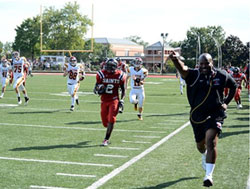 The treatment of hip labral tears and FAI is individualized to each patient. Every patient has specific life concerns, which must be taken into account while devising a treatment plan. Non-operative treatment is always instituted, regardless of whether one is an athlete or not. Even in high level athletes, there can be relative core/gluteal weakness, which can be improved. This slight change in strength can lessen symptoms from a labral tear, even to the degree that someone that was having pain improves to the extent that they do not notice pain. If surgery is ultimately required, but the patient is in the middle of the season for his/her sport, one might try to lessen symptoms but continue to perform the sport until the end of the season. This might be by using anti-inflammatory medications, continuing maintenance physical therapy, or even a cortisone injection.
The treatment of hip labral tears and FAI is individualized to each patient. Every patient has specific life concerns, which must be taken into account while devising a treatment plan. Non-operative treatment is always instituted, regardless of whether one is an athlete or not. Even in high level athletes, there can be relative core/gluteal weakness, which can be improved. This slight change in strength can lessen symptoms from a labral tear, even to the degree that someone that was having pain improves to the extent that they do not notice pain. If surgery is ultimately required, but the patient is in the middle of the season for his/her sport, one might try to lessen symptoms but continue to perform the sport until the end of the season. This might be by using anti-inflammatory medications, continuing maintenance physical therapy, or even a cortisone injection.
In my practice, the surgical treatment of hip labral tears and FAI does not differ. The bony impingement must be changed to definitively treat FAI. Labral tears should be repaired in most cases (reconstructed in a few), and labral debridement (trimming out the torn part of the labrum without repair) should be rare.
How about post-op rehab?
Post-operative rehabilitation is similar. Sometimes, elite athletes may have more time and resources to dedicate to physical therapy, so they might go more frequently. However, there is a biologic healing that has to occur after hip arthroscopy, and doubling up on exercises does not necessarily make one recover twice a quickly.
When can an elite athlete return to sport?
Every time individual is different! I may do the exact same operation, with athletes who have the same high motivation to return to sport, but the recoveries can vary. Sometimes, athletes hold off on surgery a long time, and some early arthritis has developed, which will affect the overall recovery. Getting back to sport is not solely an act of will. That being said, typically athletes in sports such as soccer, baseball, and football can return in 3-4 months. Getting back to performance level ballet is typically the longest and most arduous and can take 4-6 months, since ballet is such a hip intensive sport (YES, BALLET IS A SPORT!).
Whether an elite level athlete, a weekend warrior, or someone who likes to kick a soccer ball with their kids, everyone is entitled to a pain-free, functional hip. I personally do not treat elite athletes differently than my other patients; I TREAT EVERYONE AS IF THEY WERE AN ELITE ATHLETE.
Derek Ochiai, MD
Nirschl Orthopaedic Center
1715 N. George Mason Drive, Suite 504
Arlington, VA, USA 22205
(703) 525-2200
Twitter: @DrDerekOchiai
Website: www.Nirschl.com

